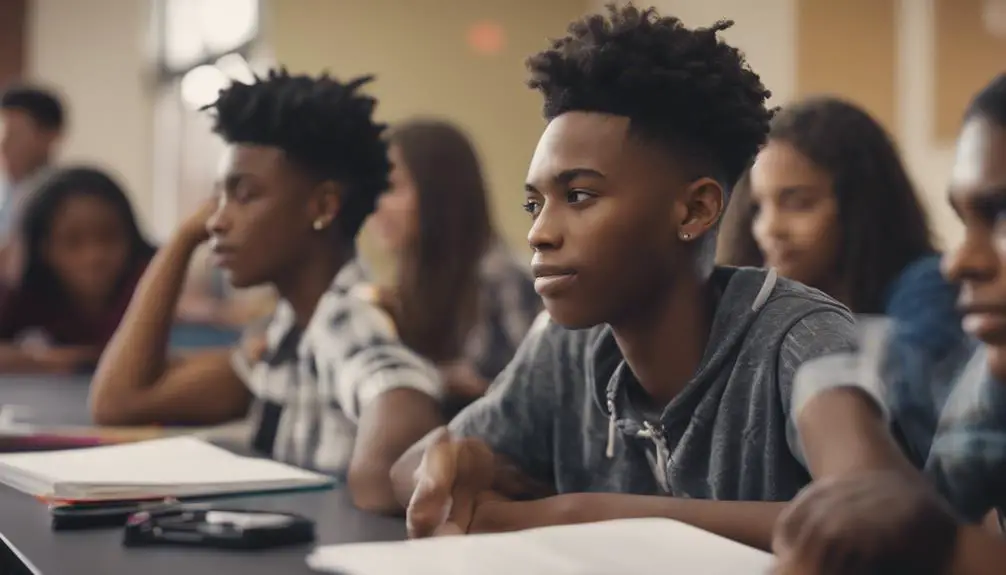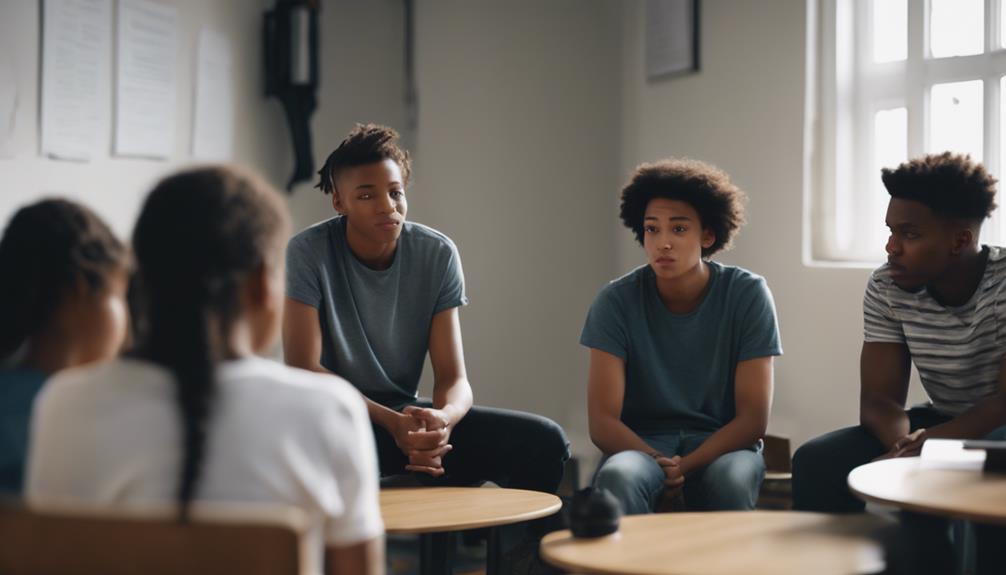Do you have students who often feel insecure and uncertain of themselves? If so, you may need to help them manage their low self-esteem.
There is no one answer for how to manage students with low self-esteem, as every student is unique. However, some general tips include providing encouragement and positive reinforcement, helping students set realistic goals, and teaching them coping and problem-solving skills. It is also important to create a safe and supportive environment in which students feel comfortable sharing their feelings and experiences.
In this article, we will discuss some tips for doing just that. First, we will explore what low self-esteem is and what causes it. Next, we will offer some ideas for helping your students build up their confidence. Finally, we will provide a few words of advice for dealing with students who struggle with low self-esteem.
Signs of Low Self-Esteem in Students
The following are some of the signs of low self-esteem in students:
1. Physical symptoms
When students have low self-esteem, they may experience a range of physical symptoms. These can include headaches, stomachaches, and other forms of pain. Low self-esteem can also lead to problems with sleep, such as insomnia or oversleeping.
Students may also find it difficult to eat properly, and they may be more likely to engage in risky behaviors like smoking or drinking alcohol. In addition, students with low self-esteem are often less physically active than their peers. All of these factors can lead to health problems in the long term.
2. Behavioral symptoms
Low self-esteem can often lead to behavioral symptoms in students. Some of these symptoms include acting out in class, being disruptive, and having difficulty paying attention. These students may also be more likely to engage in risky behaviors, such as drug and alcohol use. Additionally, they may be less likely to participate in extracurricular activities or have poor social skills.
3. Academic symptoms
Self-esteem is a feeling of worth or value that someone has for themselves. Low self-esteem means that someone feels like they are not worth anything. This can lead to a lot of problems, including academic problems.
Students with low self-esteem often have a hard time believing that they are smart or capable. This can lead to them not doing their best in school because they don’t believe that they can succeed. They may also be more likely to skip class, not hand in assignments, or get lower grades than they are capable of.
Low self-esteem can also cause students to be more reactive to criticism. If a teacher gives them a poor grade on an assignment, for example, students with low self-esteem may take it very personally and feel like they are not good at anything.
4. Social Symptoms
Low self-esteem can manifest itself in a variety of ways, but some of the most common social symptoms are: withdrawing from social activities, avoiding friends and classmates, and having a negative view of oneself.
Students with low self-esteem often feel like they don’t fit in or that they’re not good enough. They may feel shy and uncomfortable around others and maybe reluctant to participate in group activities. They may also avoid social situations altogether, preferring to stay home rather than risk being rejected or ridiculed.
These students often have a negative view of themselves, thinking that they’re not as smart or talented as their classmates. They may feel like they can’t do anything right, and that they’re not worth anyone’s time or attention.
Causes of low self-esteem in students
Below are some of the causes of low self-esteem in students:
1. Lack of self-confidence
Self-confidence is a key part of success in any field. Unfortunately, many students struggle with self-confidence issues. This can lead to low self-esteem, which can cause many problems in the students’ academic and personal lives.
There are several reasons why students may lack self-confidence. One reason is that they may not have been successful in the past. This can lead to a belief that they are not capable of succeeding in the future. Another reason may be that students do not feel good about themselves physically or emotionally. This can be due to bullying, family problems, or other issues.
The lack of self-confidence can have a negative impact on the students’ academic performance. They may be reluctant to ask for help or participate in class discussions. This can lead to them falling behind and feeling even more discouraged.
2. Peer pressure
Peer pressure is one of the main reasons why students develop low self-esteem. When teenagers are constantly comparing themselves to their peers, they start to feel like they are not good enough. This can lead to a lot of insecurity and self-doubt.
Additionally, when students are constantly put in situations where they feel like they have to behave a certain way or do certain things, it can damage their self-esteem. For example, if a student is being pressured by their friends to drink alcohol or take drugs, they may start to feel like they are not good enough unless they participate in these activities. This can be extremely damaging and can lead to long-term problems.
3. Bullying
Bullying is a problem that has been around for many years, and it seems to be getting worse. Bullying can have a lot of negative consequences for the victim, such as low self-esteem. There are several ways that bullying can cause low self-esteem in students.
One way is that bullies often target students who are already struggling with their self-esteem. The bullies make fun of them and call them names, which makes the victims feel even worse about themselves. Additionally, being bullied can lead to social isolation, which also lowers self-esteem.
Finally, bullies often use violence or threats of violence to control their victims. This can cause the victims to feel scared and helpless, which further lowers their self-esteem.
4. Academic pressure
The pressure that comes with academics can be damaging to students’ self-esteem. For some, the pressure to succeed leads to anxiety and low self-worth. The fear of not meeting expectations or being judged by others can be too much for some students.
This can lead to them feeling like they are not good enough, which can impact their self-esteem. Additionally, many students feel they have to compete with their peers, and this can also lead to a decline in self-esteem.
5. Social Media
Since the beginning of social media, people have been warning about the dangers it possesses for young people. One of the biggest dangers is how social media can cause low self-esteem in students. There are a few reasons for this.
The first reason is that social media creates an unrealistic view of life. When people only see the best parts of other people’s lives, it can make them feel like they are not good enough. The second reason is that social media can be addictive. This means that students can spend so much time on social media that they don’t have time to do things that are good for their self-esteem, like hanging out with friends or exercising.
The last reason is that social media can be mean. When people post negative comments online, it can make students feel bad about themselves.
6. Perfectionism
Perfectionism is a trait that is often seen in students with low self-esteem. For these students, the need to be perfect can be paralyzing. They become so focused on making no mistakes that they don’t take any risks and they avoid new challenges.
This can lead to them feeling like they are not good enough and that they can’t do anything right. This can cause their self-esteem to drop even further.
7. Family dynamics
Family dynamics can play a significant role in a student’s self-esteem. For example, if a student’s family is highly critical or judgmental, that student is likely to develop low self-esteem. Alternatively, if a family is supportive and loving, the student is more likely to feel confident and valued.
There are several ways in which family dynamics can lead to low self-esteem in students. For instance, if parents are overbearing or micromanaging, it can make children feel like they can’t do anything right. Alternatively, if parents are dismissive or neglectful, it can leave children feeling unsupported and unworthy.
In addition to the way parents interact with their children, the dynamics of the larger family unit can also have an impact on self-esteem.
8. Social comparison
When students compare their academic abilities to those of their classmates, they may feel inferior and have low self-esteem. This is because they may feel they cannot compete or that they are not good enough.
Social comparison can also cause students to feel bad about themselves when they compare their looks to others or when they compare their wealth to others. It is important for students to be aware of the dangers of social comparison and to understand how it can harm their self-esteem.
How to manage students with low self-esteem
From my experience, I have found the following as the main ways you can use to manage students with low self-esteem:
1. Establish trust:
The ability for a student to trust those around them is essential in order for their self-esteem to grow. When a student is not sure if they can trust the people around them, they can become guarded and closed off. This makes it difficult for them to let anyone get close to them, which can impact their self-esteem.
Establishing trust allows students with low self-esteem to feel safe and secure. It helps them feel like they can rely on the people around them, which in turn makes them feel better about themselves. When students feel like they can trust the people around them, it builds up their self-esteem.
2. Avoid criticism and judgment:
In order for students to feel comfortable in a class, it is important for them to feel safe from judgment and criticism. For some students, low self-esteem can make them especially vulnerable to such negative feedback.
There are a few things that teachers can do to help avoid criticism and judgment in the classroom. First, it is important not to put students down publicly. This will only make them feel worse and more likely to be critical of themselves. Second, try not to compare one student against another. This will only create competition and anxiety among students. Finally, give specific and constructive feedback instead of general comments that could be interpreted as judgmental or critical.
By following these tips, you can help create a more positive classroom environment where students feel safe from judgment and criticism. This will allow them to focus on learning without feeling insecure or anxious.
Click here for more articles to help you become effective in the classroom.
3. Offer compliments and encouragement:
Compliments and encouragement are two powerful tools that can be used to raise self-esteem in students. A compliment can make someone feel good about themselves, while encouragement can give them the push they need to succeed. Both of these things are important in a classroom setting.
Compliments can be given for any number of reasons. Maybe a student worked hard on a project and you want to commend them for their effort. Or maybe you noticed that they were being extra kind to a classmate and you want to thank them for it. Whatever the reason, a compliment is always appreciated.
Encouragement is also important in the classroom setting. Sometimes students need a little push to do their best or try something new. Offering encouragement can help them take that step in the right direction.
4. Help them set realistic goals:
One of the most important things educators can do for their students are help them set realistic goals. When students have achievable goals, they are more likely to feel a sense of accomplishment and raised self-esteem. In order to help our students reach their highest potential, and we need to be thoughtful in our goal setting with them.
Some considerations when helping students set realistic goals:
-The goal should be something that is important to the student and not just what the teacher thinks is important.
-The student should have some ownership over the goal and feel like it is their goal, not the teacher’s goal for them.
-The goal should be achievable within a reasonable time frame.
-The steps needed to achieve the goal should be specific and measurable.
-The student should be able to track their progress towards the goal.
In order for students to succeed in their academic careers, they need to have realistic goals. Helping students set realistic goals can raise self-esteem in students in your classroom. When students know what they need to do to achieve their goals, they are more likely to be successful. Teach your students how to break down their goals into manageable tasks that can be completed in a timely manner. Help them set deadlines for themselves and encourage them to celebrate their accomplishments along the way.
5. Celebrate their accomplishments:
Student accomplishments should be celebrated in the classroom. When students feel good about what they have done, it raises their self-esteem and helps them feel more confident in their ability to do more. This can lead to a positive spiral of success as students are more likely to take risks and try new things when they feel good about themselves.
There are many ways to celebrate student accomplishments in the classroom. One way is to have a class meeting where students share what they have done that makes them proud. This can help build community in the classroom as well as boost self-esteem. Another way is to give students tangible rewards such as stickers, certificates, or special privileges for doing something great. Whatever method you choose, make sure that it is meaningful and relevant to your students.
When students feel good about themselves, they are more likely to learn and be successful in school.
6. Create a safe and positive learning environment:
Encourage positive relationships among classmates, create opportunities for success, and emphasize effort rather than innate ability.
Creating a safe and positive learning environment is important for all students, especially those who have low self-esteem. A safe and positive learning environment can help encourage positive relationships among classmates, create opportunities for success, and emphasize the importance of effort. These things can help boost a student’s confidence and make them feel more accepted in school.
Positive relationships among classmates are important for students with low self-esteem. These students need to feel accepted and supported in order to feel comfortable and be successful in school. When classmates are positive and supportive, it encourages students with low self-esteem to participate more in class, take risks, and feel good about themselves.
In order to create a safe and positive learning environment, it is important to provide opportunities for success. This can be done by providing clear instructions, giving homework that is appropriate for the student’s level of understanding, and praising them when they do well. It is also important to emphasize that mistakes are part of the learning process. This will help students with low self-esteem feel more comfortable making mistakes and taking risks.
7. Be a role model:
Be sure to model the behaviors that you want your students to emulate. Students will learn to emulate your behavior because they like you and want to be like you.
Show your students what you expect from them. Be consistent and clear about expectations. If you are not consistent with your expectations, students will have a hard time knowing what to do in class. If a student is not performing well, they are not getting the help they need. If you don’t know what to do, ask for help from someone who does.
Be open and accessible to all the students in your class. If you are open and accessible, students will feel more comfortable approaching you. Be an example of integrity in your treatment of others.
When students have low self-esteem, it can be tough for them to feel motivated in school. One way to help these students is to be a role model for them. As a role model, you can show them that it’s possible to succeed in school even when you don’t feel confident in yourself. You can also show them how to work through their challenges and how to be resilient in the face of adversity.
One of the best things about being a role model is that you don’t have to be perfect. You can share your own experiences with your students and let them know that you’ve also had struggles and made mistakes. This can help build trust between you and your students, and it can also show them that it’s OK to make mistakes sometimes.
8. Create a positive classroom culture:
I believe in the importance of personal responsibility and self-esteem. I believe that all students have the ability to learn and succeed. Be kind, gentle, and respectful of your students and their emotions. When students feel good about themselves, they are more likely to learn and be successful in school.
9. Be an active listener:
Students don’t always express what they need. In order to help your students, you must listen to them carefully and be alert to their needs. You can also find out about their interests, likes, and dislikes by asking questions and listening to their responses.
Active listening is a great way to help boost the self-esteem of students who are struggling. When you take the time to listen attentively, you are telling that student that their thoughts and feelings matter. You are also showing them that you care about them and want to help.
Some students with low self-esteem may be hesitant to share their thoughts and feelings, but active listening can help break down those barriers. When you make a point of really listening to what they have to say, it shows them that you value their opinion and want to understand them better.
Active listening can also help build relationships with students. By establishing a rapport, you can create a more supportive environment in which they feel comfortable sharing their thoughts and feelings. This can be especially helpful for students who struggle with low self-esteem.
10. Use a variety of teaching methods:
A recent study found that students who are taught using a variety of methods have higher self-esteem and perform better in school. This is because they feel like they are learning in a way that works for them. Some students do better with hands-on instruction, while others prefer verbal explanations. A variety of teaching methods allow each student to learn in the way that works best for them.
This is also important for students who have low self-esteem. They may feel like they are not good at school or that they can’t learn in the traditional way. When teachers use a variety of methods, these students can find success in ways that work for them. This builds their confidence and helps them succeed in other areas of their life.
11. Teach social and emotional skills:
When it comes to academics, many students with low self-esteem feel like they are constantly swimming upstream. This is because their focus is on their perceived shortcomings instead of the task at hand. Social and emotional skills can help these students refocus and learn how to set goals, develop problem-solving skills, and manage stress.
One way to teach social and emotional skills is through a growth mindset approach. With this type of teaching, students are praised for effort rather than intelligence or talent. As a result, they are more likely to persevere when challenging tasks arise.
Teachers can also help students understand their emotions. For example, when a student gets angry, rather than telling them to calm down, the teacher can ask why the student is feeling that way. This type of dialogue can help students learn how to regulate their emotions in healthy ways.
12. Give specific feedback:
When it comes to working with students who have low self-esteem, it is important to give specific feedback. This type of feedback helps students focus on the process rather than the outcome. It also provides specific information about what the student did well. Avoid using general terms like “good job.” Instead, use phrases such as “you did a great job staying on task” or “I liked the way you handled that situation.” By providing specific feedback, you can help boost a student’s self-esteem and encourage them to keep trying.
Giving specific feedback can help students feel good about themselves, and it can also help them improve their skills. When students know what they are doing well, they are more likely to continue doing those things. In addition, specific feedback can help students learn new skills and strategies.
13. Help students cultivate a growth mindset:
For students, self-esteem is a critical component to success in any area of life, but especially so for students. When students have low self-esteem, it can be difficult for them to believe in themselves and persist through challenges. A growth mindset can help students with low self-esteem by emphasizing that mistakes are an opportunity to learn and providing encouragement to persist in the face of setbacks.
One way to help students develop a growth mindset is to emphasize that everyone makes mistakes. This helps students understand that it is okay to make mistakes and that they can learn from them. It is also important to provide encouragement when students experience setbacks. Students with low self-esteem may be more likely to give up after a failure, so it is important to remind them that setbacks are a natural part of the learning process.
Conclusion
Self-esteem is a vital part of a person’s development. Low self-esteem can have a negative impact on students’ academic performance, social interactions, and emotional well-being. There are several things teachers can do to help manage students with low self-esteem in the classroom. Some of them have been explained in this article. You should also be aware of the signs of low self-esteem, such as social isolation, avoidance of challenges, and poor academic achievement. Finally, pay attention to the causes of low self-esteem in students and work to avoid them.



















